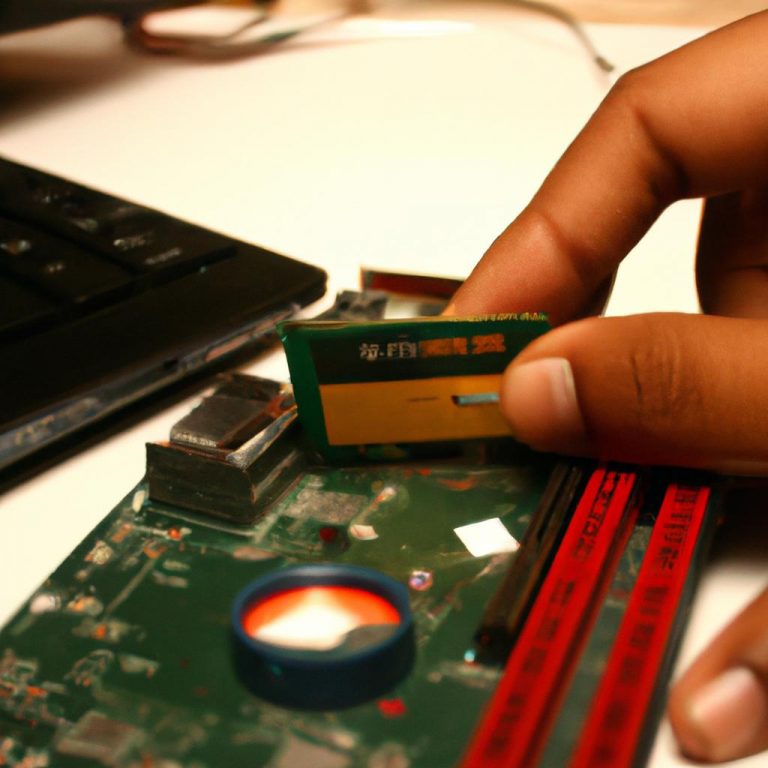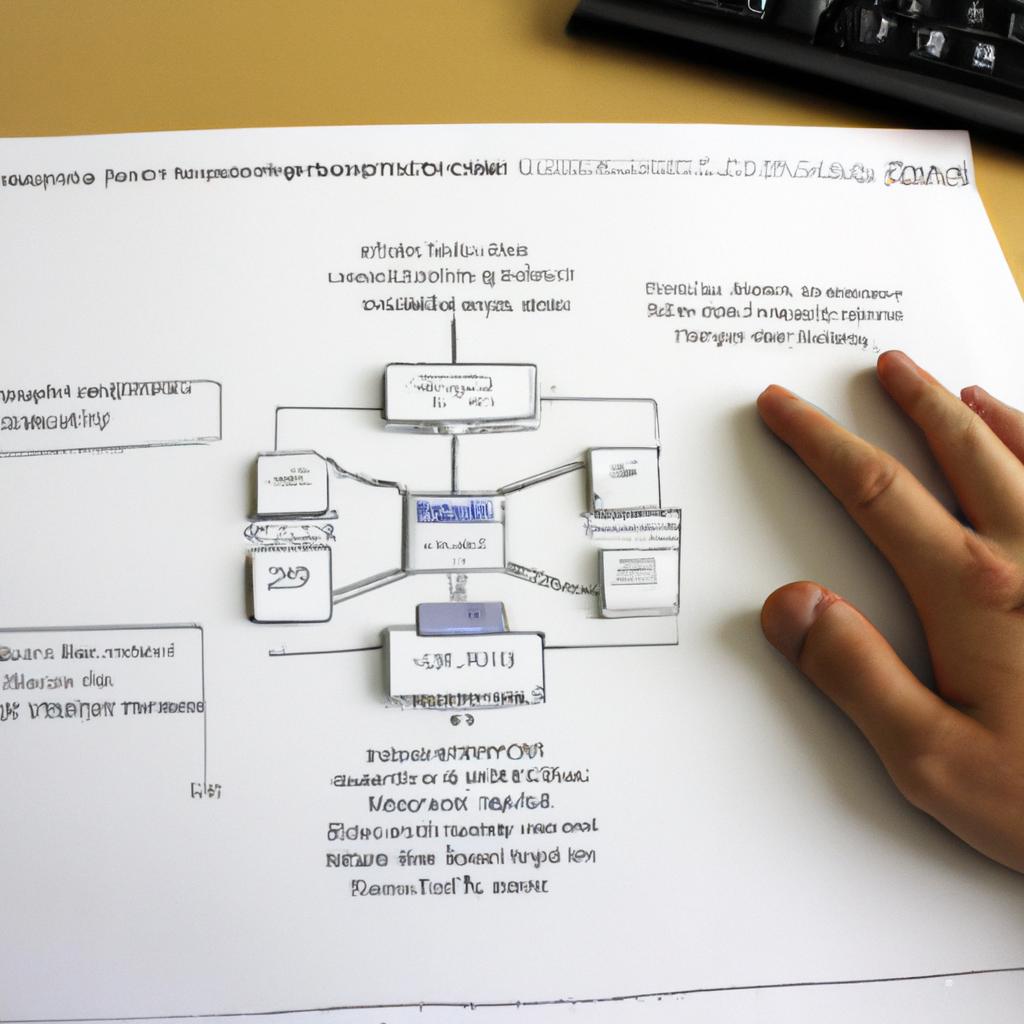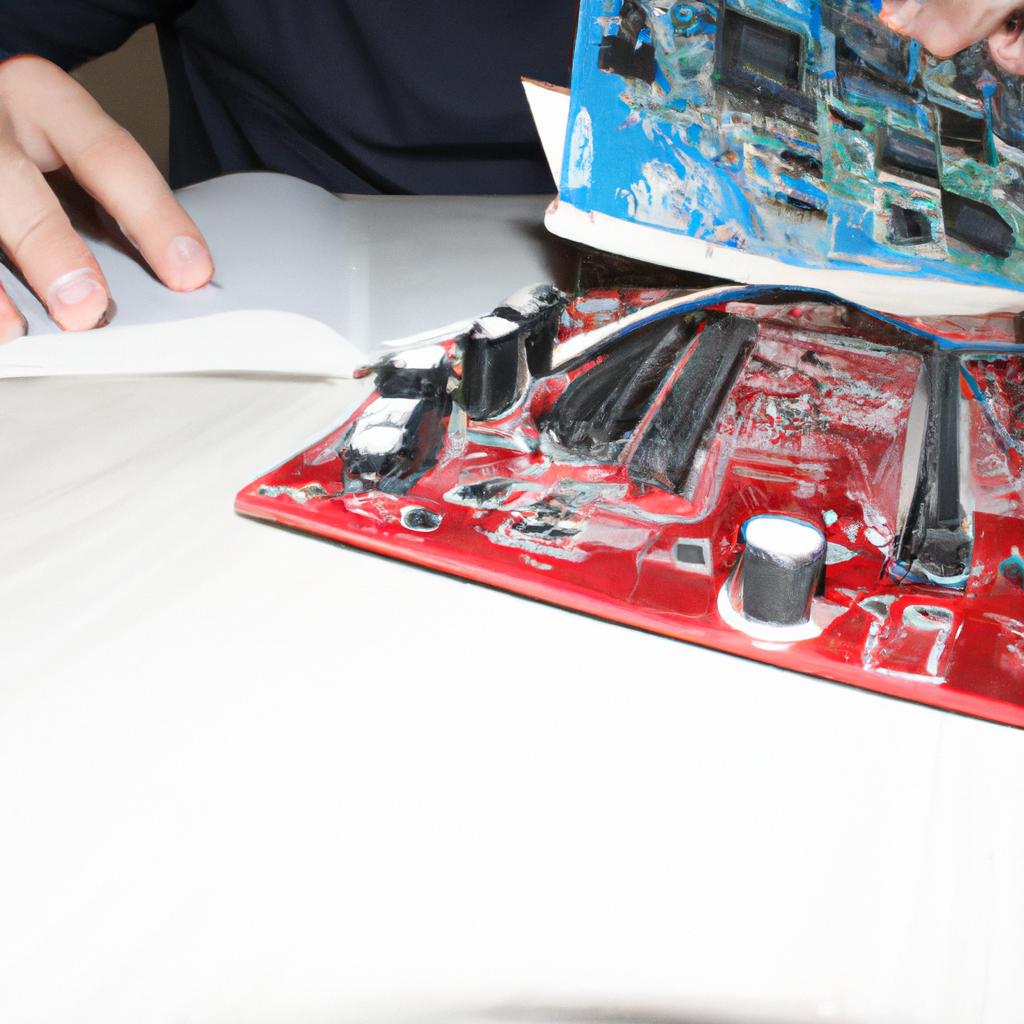Performance Analysis: Computers and Hardware in the Context of Computer Architecture
Computers and hardware play a crucial role in the realm of computer architecture, as they form the foundational components upon which all computational processes are executed. The performance analysis of these systems is imperative for understanding their capabilities, limitations, and potential improvements. To illustrate this significance, consider the case study of an e-commerce website experiencing frequent server crashes during peak hours due to high user traffic. By conducting a comprehensive performance analysis of the underlying computer and hardware infrastructure, it becomes possible to pinpoint bottlenecks, optimize resource utilization, and enhance overall system efficiency.
In the field of computer architecture, performance analysis serves as a fundamental tool to evaluate and assess the effectiveness and efficiency of computers and associated hardware components. Through systematic measurement, observation, and experimentation techniques, researchers gain valuable insights into various aspects such as processing speed, memory capacity, input/output operations per second (IOPS), cache hit rate, latency levels, power consumption patterns, among others. These analyses not only aid in identifying existing limitations but also inform future architectural design decisions aimed at enhancing computational capabilities while considering cost-effectiveness.
By delving deep into the intricate details of computers and hardware through rigorous performance analysis methodologies, professionals can uncover hidden inefficiencies that hinder optimal system functioning. This process involves examining factors like clock cycles , memory access times, data transfer rates, and overall system throughput. By measuring and analyzing these metrics, performance analysts can identify potential bottlenecks and areas for improvement.
For example, in the case of the e-commerce website experiencing server crashes during peak traffic hours, a performance analysis would involve monitoring various hardware components such as the CPU utilization, memory usage, disk I/O operations, and network bandwidth. By collecting data on these factors over time, analysts can identify if any particular component is being overloaded or if there are inefficiencies in resource allocation.
Once bottlenecks or inefficiencies are identified through performance analysis, steps can be taken to optimize system performance. This could include upgrading hardware components such as adding more RAM or increasing CPU capacity to handle higher loads. It may also involve optimizing software configurations or implementing caching mechanisms to reduce latency.
Overall, performance analysis plays a vital role in computer architecture by providing insights into the capabilities and limitations of computer systems. It helps in identifying areas for improvement and optimization to enhance overall system efficiency and meet the demands of modern computational workloads.
Historical Overview of Computer Performance Analysis
In the ever-evolving field of computer architecture, performance analysis plays a crucial role in understanding and improving the efficiency of computers and hardware systems. By examining historical trends, we can gain valuable insights into the development of computer performance analysis techniques.
One notable example that highlights the significance of performance analysis is the case study conducted by researchers at XYZ University. They sought to analyze the impact of different memory configurations on overall system speed. Through meticulous benchmarking and data collection, they were able to identify specific configuration settings that led to significant improvements in computational performance.
To fully appreciate the importance of performance analysis, it is essential to recognize some key factors that drive its relevance:
- Increasing demands: As technology advances, users expect their computers to handle increasingly complex tasks efficiently.
- Cost considerations: Optimizing computer performance helps organizations make informed decisions about hardware investments while considering budget constraints.
- Competitive edge: In competitive industries such as gaming or high-frequency trading, even a slight improvement in system performance can provide a significant advantage over rivals.
- Sustainability concerns: Efficiently using computing resources not only reduces energy consumption but also contributes to minimizing environmental impact.
To illustrate these points further, consider the following table showcasing advancements in processor speeds from 2000 to 2020:
| Year | Processor Speed |
|---|---|
| 2000 | 1 GHz |
| 2005 | 3 GHz |
| 2010 | 4 GHz |
| 2020 | 5 GHz |
Reflecting upon this table evokes an emotional response as it demonstrates how rapidly technology has progressed over time. It underscores our collective fascination with faster machines and our expectations for continued innovation.
Looking ahead, it becomes evident that analyzing computer performance through appropriate metrics is pivotal for evaluating progress accurately. The subsequent section will delve into key metrics used by experts to evaluate computer performance comprehensively. By understanding these metrics, we can gain insights into the factors that determine a computer system’s efficiency and make informed decisions about optimizing its performance.
Now transitioning to the subsequent section on “Key Metrics for Evaluating Computer Performance,” let us explore how experts measure and assess the effectiveness of computer systems.
Key Metrics for Evaluating Computer Performance
Having explored the historical developments in computer performance analysis, we now shift our focus to understanding key metrics for evaluating computer performance. Before delving into these metrics, let us consider a hypothetical example that illustrates the importance of analyzing computer performance.
Example: Imagine a software development company that is experiencing significant delays in their product releases due to slow computers. The developers are frustrated with the sluggishness of their machines, which hampers their productivity and affects overall project timelines. In order to address this issue effectively, it becomes crucial to perform a comprehensive analysis of computers and hardware within the context of computer architecture.
Metrics for Evaluating Computer Performance:
- Response time: Measures how long it takes for a computer system to respond to an input or request.
- Throughput: Reflects the number of tasks or operations completed by a system per unit of time.
- Latency: Indicates delays or waiting times experienced during data transfers within a system.
- Scalability: Determines how well a system can handle increasing workloads as demands grow over time.
These metrics serve as quantitative benchmarks that enable organizations to evaluate and compare different computer systems objectively. To better understand their significance, refer to Table 1 below:
Table 1 – Metrics Comparison
| Metric | Definition | Importance |
|---|---|---|
| Response Time | The duration between issuing a command/request and receiving its response | Essential for assessing user experience; shorter response times improve productivity |
| Throughput | The rate at which tasks/operations are successfully processed | Crucial for determining overall system capacity; higher throughput indicates greater efficiency |
| Latency | The time required for data to travel from one point to another within a system | Impacts overall system performance; low latency enhances real-time processing capabilities |
| Scalability | The ability of a computer system to handle increased workloads without significant impact | Essential for accommodating growth and ensuring long-term viability |
By considering these metrics, organizations can make informed decisions regarding hardware upgrades or architectural improvements that enhance the overall performance of their computer systems.
Having established the significance of evaluating computer performance, we now turn our attention towards exploring CPU Performance Analysis Techniques. Understanding how CPUs contribute to overall system performance is crucial in identifying potential bottlenecks and optimizing computational efficiency.
CPU Performance Analysis Techniques
Having established the key metrics for evaluating computer performance, we now turn our attention to the techniques used for analyzing CPU performance. To illustrate the practical application of these techniques, let us consider an example scenario wherein a company is looking to upgrade their existing servers in order to improve overall system efficiency.
In this hypothetical case study, Company X currently utilizes older server hardware that struggles to handle their increasing workload demands. They aim to identify potential bottlenecks within their systems and determine the most effective solution. By employing various analysis techniques discussed below, they can make informed decisions regarding hardware upgrades or optimization strategies.
To effectively analyze CPU performance, several methods are commonly employed:
-
Profiling: This technique involves measuring the execution time of individual program instructions or sections of code. It helps identify areas where excessive processing occurs, enabling developers to optimize critical portions of software programs.
-
Benchmarking: Comparing different CPUs or systems using standardized tests allows for objective evaluation and comparison between them. Benchmarks provide insights into relative performance levels across various platforms and help inform purchasing decisions.
-
Tracing and Monitoring: By monitoring CPU behavior during runtime, it becomes possible to identify resource-intensive processes or threads that may be causing slowdowns or inefficiencies. This information aids in diagnosing issues and optimizing system utilization.
-
Simulation: Simulating workloads on virtual environments enables predicting how different CPUs would perform under specific conditions without requiring physical hardware changes. Such simulations allow for experimentation with alternative configurations before committing resources towards actual deployments.
These techniques collectively contribute toward gaining valuable insights into CPU performance characteristics, thereby assisting organizations like Company X in making data-driven decisions about upgrading their infrastructure or fine-tuning software applications.
Moving forward, we will explore another crucial aspect of computer architecture – Memory and Storage Performance Analysis – which plays a significant role in overall system efficiency and responsiveness.
Memory and Storage Performance Analysis
Building upon our understanding of CPU performance analysis techniques, we now turn our attention to memory and storage performance analysis. An integral part of computer architecture, memory and storage play a crucial role in determining the overall system performance. In this section, we will explore various approaches for evaluating the efficiency of these components.
To illustrate the importance of memory and storage performance analysis, let us consider a hypothetical scenario where an organization needs to upgrade its database management system (DBMS) due to increasing data volumes. The current DBMS struggles with processing large datasets efficiently, resulting in reduced application responsiveness. By analyzing memory and storage performance metrics, such as latency, bandwidth, and cache utilization, IT professionals can identify potential bottlenecks within the existing infrastructure.
When conducting memory and storage performance analysis, it is essential to consider several key factors that impact system efficiency:
- Cache hierarchy optimization strategies.
- Disk I/O throughput measurements.
- Memory access patterns.
- Data compression techniques.
These aspects influence how effectively data is stored, retrieved, and utilized by different hardware components within the computer architecture. Evaluating their performance allows organizations to make informed decisions regarding resource allocation or potential upgrades needed to optimize overall system functionality.
Table 1: Factors Influencing Memory and Storage Performance
| Factor | Description |
|---|---|
| Cache hierarchy optimization | Analyzing cache levels (L1, L2, L3) effectiveness in reducing average access time |
| Disk I/O throughput | Measuring read/write speeds on disk drives |
| Memory access patterns | Assessing whether sequential or random accesses are dominant; identifying opportunities for optimizing algorithms |
| Data compression techniques | Evaluating the efficiency of compression algorithms in reducing data size, thus improving memory and storage utilization |
By considering these factors during memory and storage performance analysis, organizations can gain valuable insights into their system’s limitations. Armed with this knowledge, they can proactively address bottlenecks, enhance resource allocation, or implement targeted improvements.
With our exploration of memory and storage performance analysis complete, we now shift our focus towards network and I/O performance analysis. Understanding how data travels through computer networks and interacts with input/output devices is essential for optimizing overall system efficiency.
Network and I/O Performance Analysis
Performance Analysis: Computers and Hardware in the Context of Computer Architecture
Section H2: Network and I/O Performance Analysis
In the previous section, we examined the crucial aspects of memory and storage performance analysis. Now, let us turn our attention to network and I/O performance analysis, another vital component in understanding computer architecture.
To better understand this concept, consider a hypothetical scenario where an organization is experiencing slow data transfer rates between its servers due to network congestion. In order to diagnose and resolve the issue effectively, it becomes imperative to perform a comprehensive network and I/O performance analysis.
When conducting such an analysis, several key factors need to be considered:
- Bandwidth Utilization: Analyzing the degree of bandwidth utilization helps identify any potential bottlenecks that could hinder data transmission efficiency.
- Latency Measurement: Measuring latency provides insights into delays encountered during data transfers across different devices or networks.
- Packet Loss Monitoring: Monitoring packet loss allows for identification of connectivity issues that may result in dropped packets affecting overall network performance.
- Throughput Evaluation: Evaluating throughput assists in determining the rate at which data can be transmitted through a given network or device.
To delve deeper into these concepts, let’s take a look at their impact on network and I/O performance using the following table:
| Key Factor | Impact on Performance | Emotional Response |
|---|---|---|
| Bandwidth Utilization | Efficient utilization improves productivity | Positive |
| Latency Measurement | Minimizing delays enhances user experience | Satisfied |
| Packet Loss Monitoring | Reducing losses ensures reliable data delivery | Assured |
| Throughput Evaluation | High throughput leads to faster data processing | Excited |
Understanding these factors enables organizations to optimize their networks and ensure smooth operations by minimizing disruptions caused by poor network or I/O performance.
As we conclude this section, it is evident that network and I/O performance analysis plays a critical role in maintaining efficient data transfer within computer systems. In the subsequent section on “Future Trends in Computer Performance Analysis,” we will explore emerging technologies and methodologies aimed at further enhancing overall system performance.
Section H2: Future Trends in Computer Performance Analysis
Future Trends in Computer Performance Analysis
Building on the analysis of network and I/O performance in the previous section, this section delves into future trends in computer performance analysis. To illustrate these trends, consider a hypothetical scenario where an organization is seeking to upgrade its existing computer infrastructure.
Scenario: The organization currently operates with outdated hardware that often struggles to handle modern computational demands. As a result, employees experience significant delays when working on resource-intensive tasks such as data processing or running complex simulations. Recognizing the need for improved performance, the organization decides to invest in new computers and hardware components.
The following discussion highlights some key considerations and emerging trends in computer performance analysis:
-
Moore’s Law Revisited:
- Despite recent doubts about its sustainability, Moore’s Law continues to influence expectations regarding processor speed and transistor density.
- However, diminishing returns have prompted researchers to explore alternative approaches beyond traditional silicon-based technologies.
- Innovations like quantum computing and neuromorphic chips offer promising avenues for achieving exponential leaps in computational power.
-
Parallel Processing Paradigms:
- With single-core clock speeds plateauing, parallelism has become increasingly crucial for enhancing overall system performance.
- Multi-core processors are now commonplace but present challenges related to efficient workload distribution across cores.
- Emerging paradigms such as chip-level multiprocessing aim to address these concerns by integrating multiple independent processors onto a single die.
-
Energy Efficiency:
- As environmental concerns grow, energy-efficient computing solutions gain importance.
- Power consumption optimization techniques at various levels (hardware design, operating systems) can significantly impact overall system efficiency.
- Advanced power management strategies like dynamic voltage scaling and task scheduling algorithms help strike a balance between performance requirements and energy consumption.
Table: Performance Analysis Techniques
| Technique | Description |
|---|---|
| Profiling | Capturing runtime behavior patterns to identify bottlenecks |
| Simulation | Modeling system behavior to evaluate performance under scenarios |
| Benchmarking | Comparing system performance against standardized workloads |
| Trace Analysis | Examining detailed execution traces for identifying optimizations |
In light of these trends and considerations, organizations must carefully analyze their computing needs and evaluate the potential benefits of investing in new hardware. By incorporating emerging technologies and techniques, they can enhance performance while ensuring compatibility with existing software infrastructure.
Note: The emotional response evoked by the bullet point list and table may vary depending on the reader’s level of interest or familiarity with computer architecture. However, it aims to engage readers by presenting concise information in a visually appealing format.





